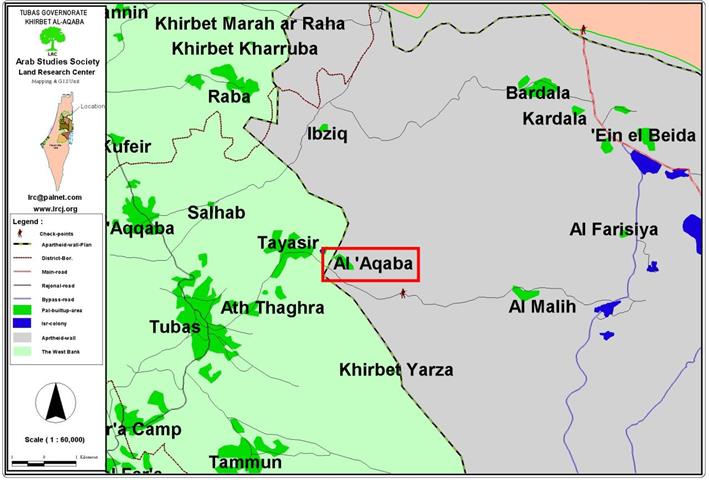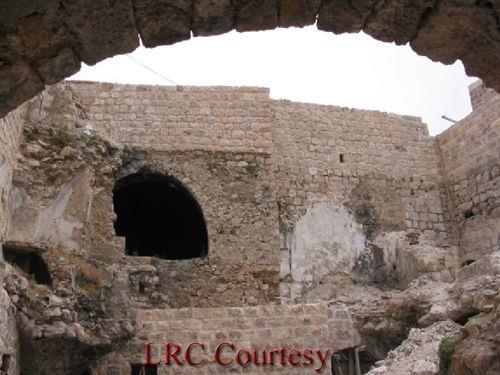Location and Population:
The village of Al Aqaba is located 7 kilometers east of the city of Tubas. Its population reaches 300 which is a significant reduction given that its population in 1967 stood at 700. The village is bordered from the west by the city of Tubas and the town of Tayaseer, the Jordan River from the east, the town of Tamoun from the south and by the villages of Bardalah and Ein Al Biedah from the north. See map of Location
The village of Al Aqaba- Tubas governorate ( in red quadrangle ) separated by the Wall
Surface Area
The current total area of the village of Al Aqaba is about 3,500 dunums owned by the residents according to the Turkish deeds (Taboo) they posses. In addition, there are 27,000 dunums owned by Latin Monetary in the town of Al Zababdeh where farmers from Al Aqaba, Tayaseer and Tubas use such lands for agricultural and grazing purposes. Moreover, there are 500 additional dunums owned by Al Aqaba residents in an area called Al Maleh. Yet, landowners are not allowed to access it due to the continuous Israeli military trainings in the said area.
Built-Up Scheme
The Village Council is currently suing the Israeli government to force it to produce a detailed schematic built-up plan of the village which lies in Area C according to the Oslo Agreements' divisions.
Colonial Violation
1. Submitting demolition orders against the village's mosque, kindergarten, a room that contains an electrical generator, in addition to a number of Zinco houses. See Photo 1 & Photo 2
Photo 1: Al Aqaba- Tubas: the village mosque threatened with demolition, :
Al Aqaba- Tubas: the village mosque threatened with demolition, Photo courtesy of LRC
Photo 2: Al Aqaba- Tubas: the kindergarten threatened with demolition, :
Al Aqaba- Tubas: the kindergarten threatened with demolition, Photo courtesy of LRC
The demolition of two barracks that were used for housing and herd raising purposes. Detailed information in this regard are provided in the following table:
|
Name |
Notification Date |
Demolition Date |
No. of Family Members |
Surface Area |
Usages |
Demolition Pretext |
|
Nayef Abdel Kareem Saleh |
22/10/03 |
23/12/2003 |
8 |
70 |
Housing |
Built in a Closed Military Area |
|
Akram Mohammad Saleh Taleb |
22/10/03 |
23/12/2003 |
8 |
300 |
Housing and animal shed |
Built in a Closed Military Area |
|
Total |
16 |
370 |
|
|
||
Photo 3 & Photo 4: Al Aqaba- Tubas: ruins of demolished barracks, :
Al Aqaba- Tubas: ruins of demolished barracks, & : Al Aqaba- Tubas: ruins of demolished barracks, Photos courtesy of LRC
3. The demolition of a water collection pool, a capacity of which was 200 cubes used to be used for watering the crops and the herds.
4. Informing area residents of the confiscation of all of Al Aqaba village as a prelude for the erection of the Israeli Apartheid Separation Wall.
General Background
Palestinians lived in Al Aqaba village since ages in tents and caves. Tens of families used to live in the village until the Six Day War forced a large number of these families to flee for their lives into Jordan and nearby townships, such as Tayaseer, Tubas and Nablus. See Photo 5 & Photo 6
Al Aqaba- Tubas: samples of the village dwellings made of barracks and tents, Photos courtesy of LRC
After the 1967 War the Israeli Army declared the village to be a closed military area. In 1968 two military training camps were established on the eastern edge of the village followed by another such camp on its western entrance. A third camp was established in 1983 leading to an accelerated suffocation of the village.
Moreover, Israeli occupation forces have, throughout the years, prevented the development of any basic infrastructure in the village. A change of heart took place in 1997 when an elementary school was established (currently serving 64 students). The basic services continued to be established afterwards such as a local clinic (established in 2001 with the aid of the British Consulate), a kindergarten (in 2002 with the financial aid of the Belgium Representative), a village council in 1997, a local NGO (called Countryside Women Society) in 1998 as well as the installation of an electricity generator in 1999.
LRC's Field Visit
LRC's field representative conducted an interview with Hajj Sami Sadeq, the head of the village council and a land activist. Hajj Sadeq stated:
'' The Israeli Army has exerted extensive pressure on the residents of the village since 1967 to force them to leave. One of the methods used included declaring the entire village as a Closed Military Area as well as frequent shooting at the houses, herds and the residents. Moreover, military maneuvers and trainings using live ammunitions were conducted frequently to terrorize and to, thus, force the residents out of their village. Such hostile acts have led to the martyrdom of 8 residents and the injury of more than 50 throughout the years. I, for one, was hit on 28/6/1971 with three live bullets leaving me paralyzed ever since. There are a lot of barbaric acts committed by the Israeli Army such as what took place in 1999 when soldiers destroyed the electrical and phone networks as well as confiscating the heavy machinery used to rehabilitate the main and only road the village has. The Army also demolished a number of houses and barracks as we were prevented from building in the village since the occupation began in 1967''.
Developmental Activities in the Village
Hajj Sadeq added that starting from 1993 the residents of the village, in collaboration with governmental and non-governmental organizations, carried out a number of projects in the village, including the following:
-
The formation of a local village council to oversee the affairs of the residents of the village;
-
Digging up a number of wells used for water collection.
-
Repairing the main road leading to the village;
-
Rehabilitating the basic school, establishing a kindergarten, a mosque, a clinic as well as the Countryside Women Society all of which has an Israeli demolition order against them.
-
Contacting national and international media to foreshow the problems and the suffering of the village due to Israeli practices.
Legal Proceedings
In 1999 the residents of the village filed a lawsuit against the Israeli Army to stop its live-ammunition maneuvers and trainings inside the village as well as to remove its military encampments located in the vicinity of the village. In the court hearing held on 20/9/2002 residents were informed that one of the camps was set to be removed in November 2002. However, it was removed on 12/6/2003!!!.
Immediately after the removal of the camp the residents began to establish a mosque and continued the establishment of the kindergarten, the clinic, the electricity generator room as well as a number of houses and barracks. As mentioned earlier, two barracks were demolished on 23/12/2003 despite the fact that the residents of the village went to the Israeli High Court, the Israeli Education Department and a number of human rights' organizations to stand firmly against executing such demolitions.
Hajj Sadeq also mentioned that some of the houses of the village were built of cement and stones yet without rooftops except for Zinco plates as to avoid its destruction by the Israeli Army. Finally, he said that, according to maps published by the Israeli Defense Department, the village as a whole would lie behind the Israeli Separation Wall. ''The worst in yet to come,'' he emphasized.
Problems Faced by Villagers Due to Israeli Practices
-
Due to the continuous nature of Israeli attacks and pressure, the deprivation of the most basic services and the incessant suffering of the residents of Al Aqaba, most of them left to nearby villages, townships and cities.
-
In case the Wall is built it would lead to the isolation of the village from its immediate vicinity which would lead to the suffocation of all forms of viable life in the village as its land would be confiscated and all services would come to a screeching halt.
-
The residents of the village live in an unremitting struggle with the Israeli Army in an effort to keep hold of their land and their heritage. That is the case despite the fact that the Army burns and destroys their agricultural crops on yearly basis as well as field destruction under the pretext of using them for ''military maneuvers.''
-
Children face death on daily basis due to Israeli maneuvers using live ammunitions.
-
The deterioration of the economy of the village due to crops burning and the prevention of market access by the Israeli Army. This has led to a sharp decline in the living standards of the residents of the village.
An Appeal:-
Hajj Sami Sadeq has made this appeal during his interview with LRC's representative: ' I strongly appeal on behalf of Al Aqaba residents to all governmental and non-governmental organizations, especially those concerned with human rights and the right of housing, to support the right of Al Aqaba residents to live in their houses and village. I, also, call upon them to put an immediate end to Israeli measures against the residents of the village. In case the villagers were forced out, the Israeli Army would be able to easily confiscate thousands upon thousands of dunums in Al Aghwar region ( Jordan Valley). The Israeli High Court is going to hold a hearing on 2/6/2004 to discuss the issue of a Built-Up Scheme for the village and to stop the frequent house demolitions. We call upon all peace-loving institutions to support us in our cause'.
Prepared by
The Land Research Center
LRC





















